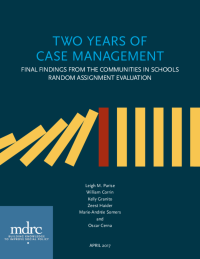Two Years of Case Management
Final Findings from the Communities In Schools Random Assignment Evaluation

While high school graduation rates are on the rise nationwide, too many students still never reach that milestone, with 7,000 on average dropping out every day. Recognizing that many students need additional support to succeed in school, Communities In Schools (CIS) works to provide and connect students with integrated support services to keep them on a path to graduation. CIS makes some services broadly available to all students at a school, and provides individual case management to those deemed most at risk of dropping out.
This report presents the final implementation and impact findings from a two-year randomized controlled trial of CIS case management. This trial is half of a two-pronged national evaluation, the other half being a quasi-experimental study of the whole-school model. The report describes the implementation and effects of CIS case management in 24 mostly urban, low-income secondary schools in two states during the 2013-2014 school year. The study’s implementation research finds:
- CIS site coordinators directly provide many services and also connect students with local partners and extant in-school services. While partner and in-school service providers help CIS meet students’ needs, it is challenging to monitor and evaluate their services’ quality.
- During the second year of the study, approximately 80 percent of the students assigned to case management received services. These students received services an average of 20 times, for an average of just over 18 hours. Students classified as being at high risk of dropping out received services at a lower rate than moderate-risk students.
- CIS case-managed students participated in support activities more frequently than non-case-managed students overall.
The study also estimated the effect of case management on students’ nonacademic and more traditional school outcomes. After two years, the study found that case management had a positive effect on several nonacademic outcomes, including students’ attitudes about school and their relationships with adults and peers. However, the study also found that case management did not improve students’ school progress, achievement, attendance, or behavior.
The final chapter of this report includes implications for practice based on the evaluation findings: ensuring that high-risk students receive the most attention; keeping students engaged with services; monitoring and adjusting services over time; working to ensure the quality of services from partner organizations; and emphasizing students in transition grades. CIS’s national office has already begun to implement changes based on the results of this evaluation.
The report concludes by considering the results of this random assignment study of case management together with the results of the quasi-experimental analysis of the whole-school model. Taken together, the results suggest that whole-school models of integrated student support offer the promise of positive effects. The results also indicate, however, some areas to which support providers may need to pay close attention, to ensure that students receive services that address their specific needs and that benefit them above and beyond the services already available.






